The largest phylum of marine animals is:
1. Arthropoda 2. Echinodermata 3. Cnidaria 4. Mollusca
In metamerism, there is serial repetition of unit subdivisions of:
| I. | Ectoderm products |
| II. | Mesoderm products |
| III. | Endoderm products |
| 1. | Only II | 2. | Only I and II |
| 3. | Only II and III | 4. | I, II and III |
In a typical mollusc:
| I: | Head, muscular foot and visceral hump are body segments. |
| II: | Mantle over the visceral hump is formed by a layer of skin. |
| III: | Radula is a file-like rasping organ |
| 1. | Only III is correct |
| 2. | Only II and III are correct |
| 3. | Only I and III are correct |
| 4. | Only I and II are correct |
Bilaterally symmetrical animals can be acoelomate, pseudocoelomate, or coelomate. Study the diagrammatic representation of body cavity and the animal illustrated in diagrams A to D.
| A. | 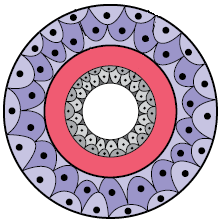 |
 |
Triploblastic acoelomate solid mesoderm |
| B. | 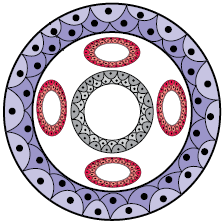 |
 |
Pseudocoelomate partially open coelom, formed by retention of embryonic blastocoel |
| C. | 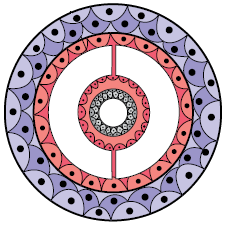 |
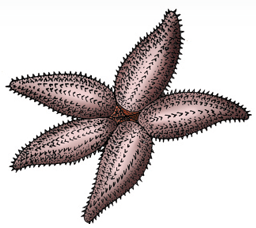 |
Coelomate, body cavity lined by mesoderm |
| D. | 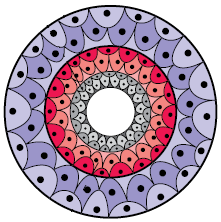 |
 |
Diploblastic acoelomate |
How many of the above illustrations are correct?
| 1. | Four | 2. | Three |
| 3. | Two | 4. | One |
Diagrams (A, B, C and D) of four different animals are given below. Which one of the following option identifies the animal, its phylum and one of its characters correctly ?
| Animal | Phylum | Character | |
| B | Rana | Amphibia | 3 – chambered heart |
| C | Asterias | Echinodermata | Water canal system |
| A | Aurelia | Coelenterata | Cnidoblast cells |
| D | Naja | Chordata | Non-poisonous snake |
1. B
2. C
3. A
4. D
An animal with the following body wall organization will not have:

1. Cephalization
2. Three germ layers
3. Bilateral symmetry
4. A complete digestive tract
Identify the incorrectly matched pair:
| Animals | Feature present in both | |
| 1. | Balanoglossus and Pinctada | Open circulatory system |
| 2. | Branchiostoma and Ascidia | Persistent notochord |
| 3. | Aplysia and Pheretima | True coelom |
| 4. | Gorgonia and Pennatula | Cnidoblasts |
Given below are two statements:
| I: | Amphibians and reptiles have a 3-chambered heart with two atria and a single ventricle, and are oviparous in nature |
| II: | Crocodiles possess a 4 chambered heart with two ventricles and two atria and are viviparous in nature |
Select the most appropriate option:
1. I is correct but II is incorrect.
2. I is incorrect but II is correct.
3. Both I and II are correct.
4. Both I and II are incorrect.
What will you look for to identity the sex of the following? Select the correct match.
| 1. | Male frog – a copulatory pad on the first digit of the hind limb |
| 2. | Female cockroach – anal cerci |
| 3. | Male shark – claspers borne on pelvic fins |
| 4. | Female Ascaris – sharply curved posterior end |
| Animal | Excretory organs | Excretory product | |
| 1. | Labeo (Rohu) | Nephridial tubes | Ammonia |
| 2. | Salamander | Kidney | Urea |
| 3. | Peacock | Kidney | Urea |
| 4. | Housefly | Renal tubules | Uric acid |





